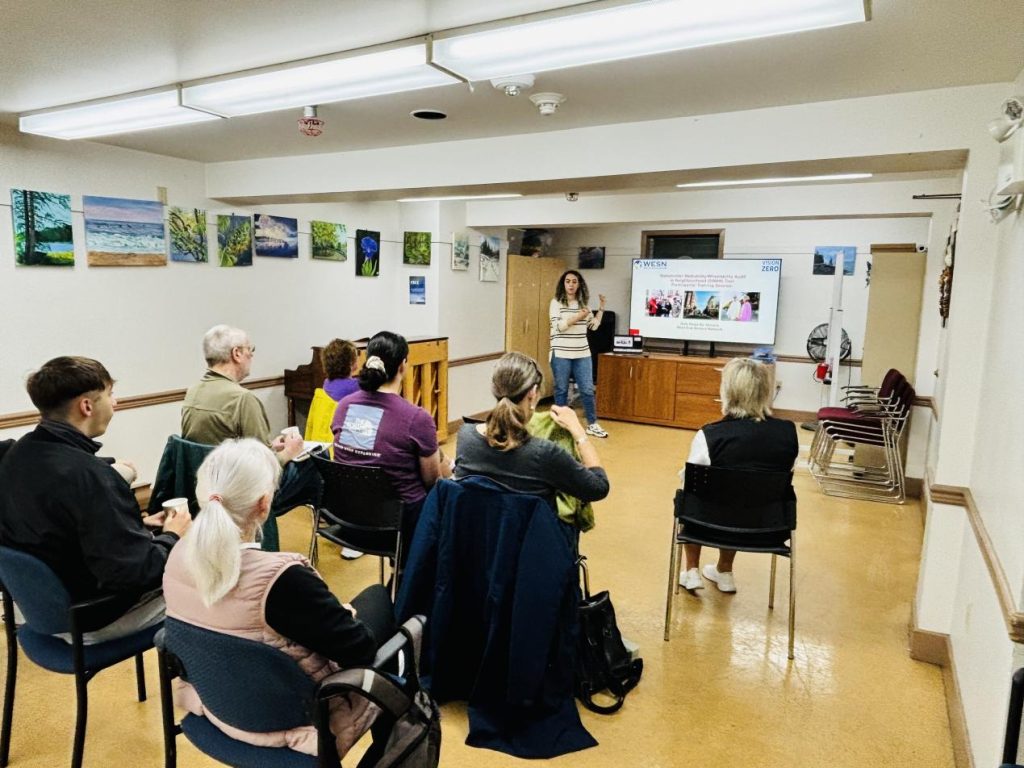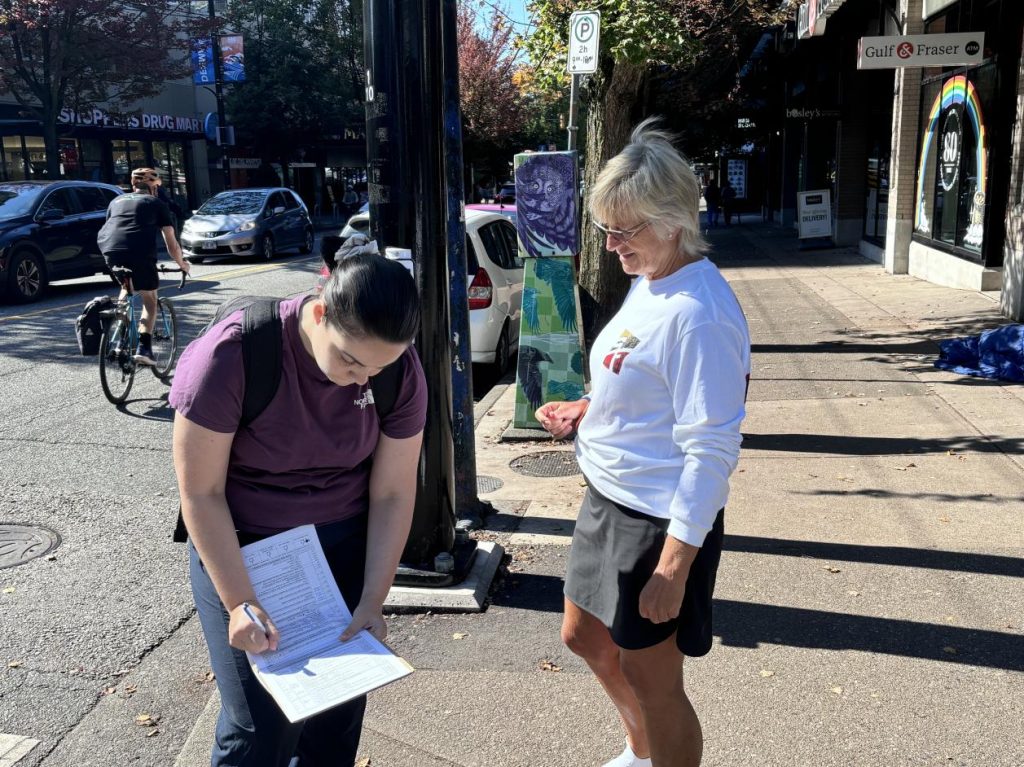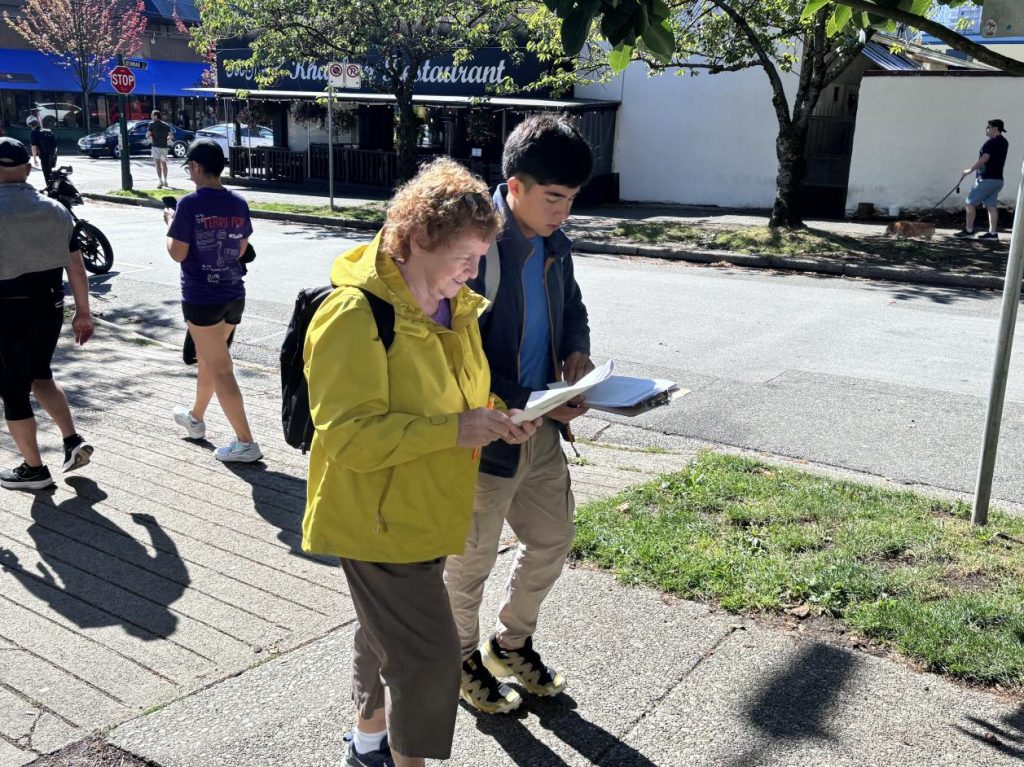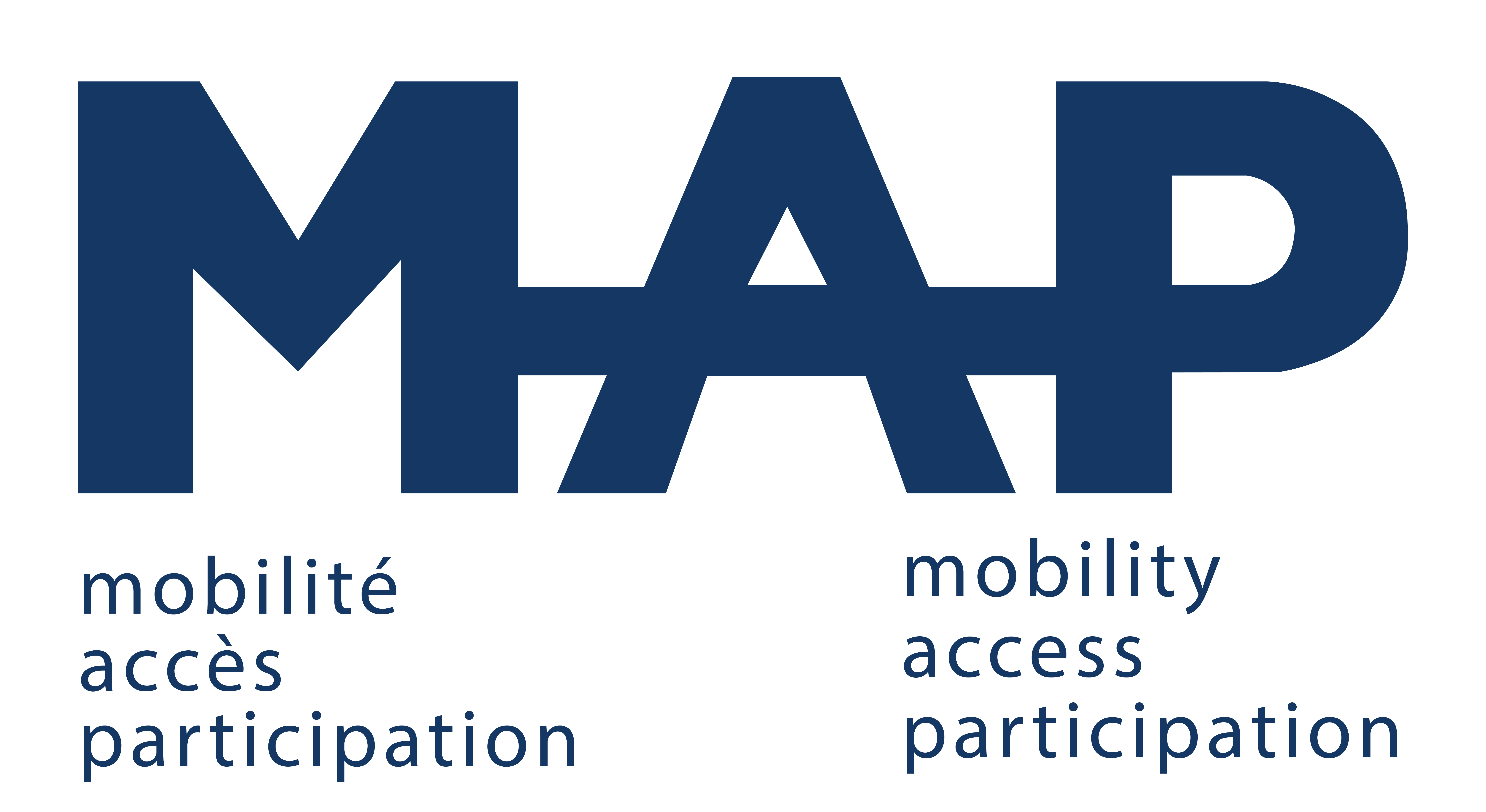Gains From Safe Steps for Seniors
Siding Wang (Sandy), Samna Sadaf Khan, Atiya Mahmood

According to the 2020 West End Social Indicator Profile, 37% of West End residents experience limitations in daily activities, which is 6% higher than the city average. This limitation is particularly pronounced among older adults and seniors aged 65 and above, among whom the rate of activity limit is 60%. In terms of geographical location, the West End neighbourhood is located south of Stanley Park and east of English Bay, with a population density five times higher than the city average. The large tourist stream near the sightseeing sites, especially the prevalence of cycling near the park, complicates its traffic conditions. Such demographic and geographic characteristics suggest attention should be paid to the neighbourhood’s walkability for seniors. During my internship as a research assistant in the Department of Gerontology at Simon Fraser University, I participated in a community-based research project at West End Senior Network. Funded by Vision Zero, an organization aiming to improve road safety, this project assesses environmental challenges to seniors’ walkability in the West End neighbourhood and provide guidance for further local intervention.
The project employed a mixed-methods approach, combining quantitative and qualitative methodologies. Quantitative data was collected using ‘Stakeholders’ Walkability/Wheelability (SWAN)’ Audit in Neighborhoods to evaluate the walkability of seven key locations, while qualitative data came from two sources. The first source was an online pre-survey questionnaire, in which West End’s senior residents (n=82) were asked to describe issues in the areas they suggested for audit before the locations were chosen. The second source was a series of focus group discussions held immediately after each outdoor audit, where participants were asked to identify problems they observed during the audit as well as their past experiences in the neighborhood. Key locations to audit were identified based on responses to the pre-survey, which asked the open-ended question, “Where are some areas we should audit?” with four blanks for respondents to provide their answers. Respondents were then requested to “be specific by listing exact intersections or providing detailed descriptions of specific areas. Also, please indicate the issues you have in these areas”.
Although the research project originally focused on identifying road safety issues using a quantitative audit tool, qualitative data from the pre-survey and the first focus group discussion in which I participated provided an inspiring illustration of how elders in the West End neighborhood perceive, analyze, and may contribute to solving these problems—all rooted in their experiences as members of a constantly changing community. Studies have noted that older adults are often perceived as either individuals or members of an institution, whereas older adults themselves are more accurately seen as participants in a dynamic group process that is continually constructed and reconstructed (Bookman 2008). The qualitative data informed the following sections of my writing, where I will discuss the issues mentioned by the participants and share how their way of articulating these issues impressed me, shedding light on the design and implementation of an age-friendly community.

1. Physical Obstacles on the Sidewalk: “I Wish I Would Do it Myself”
The pre-survey reported some sections of the sidewalk to be narrow, uneven, cracked, or bumpy, with safety hazards exacerbated by certain weather conditions. Some places were described as “slippery in icy weather”, and some areas accumulated pools of water “too deep to walk through when it rains”. In addition to these surface problems, participants noted a lack of street amenities, frequently mentioning the need for benches, shelters at transit stops, and other seating options. Poor street lighting at night was also reported, diminishing participants’ sense of security. It is important to note that the lack of safe physical features affects not only the immediate experience of walking on certain roads, but also shapes residents’ walking behavior in terms of route selection, as a participant in the focus group discussion commented, “I think the biggest issue is the lighting, and so I try to avoid certain places”.
In the focus group discussion, while discussing the root system under the sidewalk, which had raised uneven sections and created a “life-affecting situation”, one participant mentioned that they did not receive a positive reply when submitting the issues to the city and requesting paint warnings. “Sometimes I wish I would just take a can of red paint to do it myself,” said the participant. This sentiment was echoed by several other participants. As participants reported, repairing sections of the sidewalk is often not a priority for the city, indicating a discrepancy between what the city does and what the elderly actually need. Moreover, the idea of marking hazards themselves highlights a critical aspect of older adults as community builders, suggesting a collaborative approach to community management in which the older adults are not just passive recipients of resources.
2. Ambiguity in Traffic: The Need for a Standardized Regulation Accessible to All
Aside from the physical features of the sidewalk, another set of factors hindering pedestrian safety is concerned with traffic. In the pre-survey, several participants reported “undifferentiated spaces” shared by both cyclists and pedestrians. More than 10 participants mentioned scooters and bicycles on the sidewalk. This situation is exacerbated for seniors with poor hearing, who “cannot hear the cyclists approaching”. While some are caused by people intentionally violating the rules, others are caused by ambiguity regarding the right of way. As explained by one respondent who reported themself as an urban planner, “What pedestrians do not know is that this route is part of a much wider bikeway route and having it on the map, creating the impression for the cyclists that they do really have the right of way.” Additionally, more than ten participants mentioned problems in detecting traffic situations, the most dangerous of which is the cars’ blocked vision. One respondent noted, “Drivers have trouble seeing pedestrians crossing from the park side due to the distraction of the middle lanes of cyclists”. Distractive noises, such as horns and sirens, were also mentioned as a concern.
In the focus group, when discussing the problem of traffic safety, participants soon reached to the core problem– “Pedestrians and drivers are both confused, and cyclists, because no one knows what to do”. According to the discussion, the collective confusion results in chaos on the road, generating frustration and aggression, which is exacerbated by the time limitations. The ambiguity in traffic regulation is further compounded by the absence of accountability. One participant in the focus group expressed that many traffic signs are not mandated by law. “But you ask a policeman, what is this red line here? What is this red square? Do I get a ticket if I park here? He hasn’t got a clue. There’s no law applicable to it, they’re just making these things up”.
Participants agreed that inconsistency in traffic design has contributed significantly to this problem. Not only is there inconsistency within the neighborhood, but inconsistency with other areas in terms of traffic regulation can also be an issue, especially when it comes to the West End. “I think what we are challenged within our community is that we have a lot of people that aren’t from here, and where they’re from, the traffic, the roundabout was managed in a different way… it would be nice if we could get some more support at that stage where driving a car is different experience”. The participant mentioned that the advanced green (a type of traffic light signal) is specific to British Columbia, which might confuse people from other places. Later in the discussion, another participant also noted the wayfinding problem “for strangers to the neighborhood”. As the West End becomes a multicultural neighborhood, it is encouraging to see that participants are genuinely concerned with the experiences of people who are new to the area. The participants are not just complaining about the obstacles they themselves faced but are genuinely considering people from different groups as stakeholders. I believe that this also sheds light on what equal accessibility means within a community.
3. Worries about Social Safety and Interaction: The Complex Dynamics of Community and Active Engagement
Most quantitative evaluative tools measure how the built environment supports a sense of community by the availability of public amenities and street furniture that fosters social interaction (Kan & Molinsky 2020). This, however, is not the only dimension where the social aspects of a neighborhood are embodied. The West End neighborhood had an overall high evaluation in terms of facilities, as commented by one participant in the focus group, “(West End is) probably one of the best places in the world in terms of peace and amenities”. Nevertheless, as the place changes over time, more problems regarding socializing in the neighborhood, including concerns on safety and interaction have arisen.
When discussing interactions with people that made them feel unsafe, one participant shared their experience of hearing hate speech and addressing the problem with a call to 911. This was followed by another participant, “What do you do if it doesn’t warrant a 911 call? Like, people are yelling and creating a feeling that it’s a bit hostile?” The situation of encountering unfriendly behavior in the community was experienced by another participant, who commented, “But we don’t have anything in our society that says, ‘Excuse me’, that’s not allowed in this way of living… that’s not how we work with each other”. This raised a critical point to the norms of interaction that shape the mezzo-level community, namely, how does community dynamics address circumstances that are insufficient to trigger police intervention but also beyond the control of individuals? The phenomenal approach to place emphasizes that people’s everyday experiences are integral to the place (Rowles 1983), and the impression of unfriendliness could negatively affect elderlies’ walking experience. “I think you always have to make a judgment when you’re coming up to somebody to whether you’re going to avoid or stop”. Everyday micro-interaction with pedestrians serve as an important source of social engagement, as studies on social interaction have shown that positive affective reaction could be elicited by brief exchanges such as eye contact (Hietanen 2018).
Also related to social engagement in a multicultural community is the language barrier. In explaining her experience of hearing languages she didn’t understand, one participant expressed that while “it’s neat to hear all the other languages” in the cosmopolitan community, she felt that when she tried to interact with people speaking different languages, “it’s almost like it’s a wall around them”. A second participant then recommended a translation application, which “is wonderful and does make that connection”. While some studies have shown that population turnover may increase older people’s sense of losing control over their environment (Buffel & Phillipson 2018), it is encouraging to see that participants are actively trying to connect with others in the neighborhood.
Rather than viewing the situation as static and simply identifying what is lacking, they aimed to uncover the complex origins of the problem. A typical case discussed was a former gathering place on a street corner, which had been “taken over by a group of people that lead different lifestyles” and was described by one participant as “very disconcerting”. Another participant explained that the city removed the area due to concerns over undesirable gatherings, “In dealing with the non-desirable grouping of people, (the city) removed some of the support sitting places for people who generally need them”. Recounting a friend who walked with canes and used to rest there, they commented, “who are suffering here are the people who could use the spaces”. This phenomenon was documented in the pre-survey as well, where a participant mentioned “people openly drinking, sprawling on benches which no one else can use”. This case suggests that some problems may not have simple solutions that can be resolved solely by adding physical resources, echoing recent criticisms on age-friendly design regarding an objected-focused, solution-driven approach where older people’s need is generically presumed (Handler 2018).
What is needed is an alternative approach where older adults are consulted and engaged in an age-friendly urban design. The multifaceted nature of safety is reflected in the problems regarding physical safety, traffic regulation and social integration in a changing neighbourhood. Beyond these challenges, we have also seen how the participants of Safe Steps for Seniors perceive problems in their neighbourhood from a relational, context-specific way. They view other stakeholders in the city, and which may inform further approach with a more agent-focused community building and management.

References
Bookman, A. (2008). Innovative models of aging in place: Transforming our communities for an aging population. Community, Work & Family, 11(4), 419-438.
Buffel, T., & Phillipson, C. (2018). A manifesto for the age-friendly movement: Developing a new urban agenda. Journal of aging & social policy, 30(2), 173-192.
Handler, S. (2018). “Alternative Age-Friendly Initiatives: Redefining Age-Friendly Design.” In Age-Friendly Cities and Communities: A Global Perspective (pp. 211-30), edited by T. Buffel, S. Handler, and C. Phillipson. Policy Press.
Hietanen, J. K. (2018). Affective eye contact: An integrative review. Frontiers in psychology, 9, 1587.
Kan, H. Y., Forsyth, A., & Molinsky, J. (2020). Measuring the built environment for aging in place: A review of neighborhood audit tools. Journal of Planning Literature, 35
Rowles, G. D. (1983). Place and personal identity in old age: Observations from Appalachia. Journal of environmental psychology, 3(4), 299-313.
West End Social Indicators (2020): https://vancouver.ca/files/cov/social-indicators-profile-west-end.pdf


